10.1: Angles and their Measure
( \newcommand{\kernel}{\mathrm{null}\,}\)
This section begins our study of Trigonometry and to get started, we recall some basic definitions from Geometry. A ray is usually described as a `half-line' and can be thought of as a line segment in which one of the two endpoints is pushed off infinitely distant from the other, as pictured below. The point from which the ray originates is called the initial point of the ray.
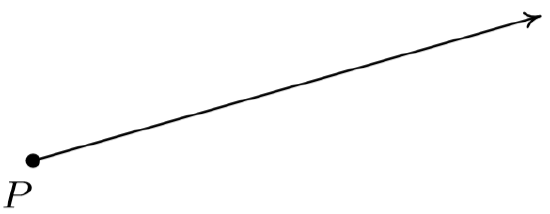
A ray with initial point P
When two rays share a common initial point they form an angle and the common initial point is called the vertex of the angle. Two examples of what are commonly thought of as angles are

(left) An angle with vertex P. (right) An angle with vertex Q.
However, the two figures below also depict angles - albeit these are, in some sense, extreme cases. In the first case, the two rays are directly opposite each other forming what is known as a straight angle; in the second, the rays are identical so the `angle' is indistinguishable from the ray itself.

A straight angle.
The measure of an angle is a number which indicates the amount of rotation that separates the rays of the angle. There is one immediate problem with this, as pictured below.
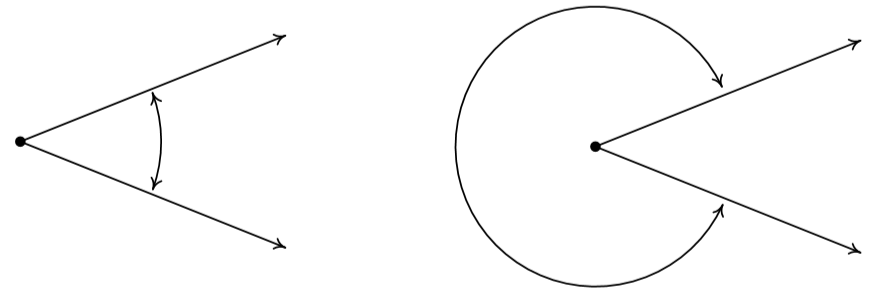
Which amount of rotation are we attempting to quantify? What we have just discovered is that we have at least two angles described by this diagram.\footnote{The phrase `at least' will be justified in short order.} Clearly these two angles have different measures because one appears to represent a larger rotation than the other, so we must label them differently. In this book, we use lower case Greek letters such as α (alpha), β (beta), γ (gamma) and θ (theta) to label angles. So, for instance, we have

One commonly used system to measure angles is \index{angle ! degree}\index{degree measure}\textbf{degree measure}. Quantities measured in degrees are denoted by the familiar `$^{\circ}$' symbol. One complete revolution as shown below is 360∘, and parts of a revolution are measured proportionately.
Note
The odd choice of `$360$' is most often attributed to the Babylonians.
Thus half of a revolution (a straight angle) measures 12(360∘)=180∘, a quarter of a revolution (a right angle) measures 14(360∘)=90∘ and so on.

Note that in the above figure, we have used the small square `$\! \! \! \! \! \! \qed$' to denote a right angle, as is commonplace in Geometry. Recall that if an angle measures strictly between 0∘ and 90∘ it is called an \index{acute angle}\index{angle ! acute}\textbf{acute angle} and if it measures strictly between 90∘ and 180∘ it is called an \index{obtuse angle}\index{angle ! obtuse}\textbf{obtuse angle}. It is important to note that, theoretically, we can know the measure of any angle as long as we know the proportion it represents of entire revolution (this is how a protractor is graded). For instance, the measure of an angle which represents a rotation of 23 of a revolution would measure 23(360∘)=240∘, the measure of an angle which constitutes only 112 of a revolution measures 112(360∘)=30∘ and an angle which indicates no rotation at all is measured as 0∘.

Using our definition of degree measure, we have that 1∘ represents the measure of an angle which constitutes 1360 of a revolution. Even though it may be hard to draw, it is nonetheless not difficult to imagine an angle with measure smaller than 1∘. There are two ways to subdivide degrees. The first, and most familiar, is decimal degrees. For example, an angle with a measure of 30.5∘ would represent a rotation halfway between 30∘ and 31∘, or equivalently, 30.5360=61720 of a full rotation. This can be taken to the limit using Calculus so that measures like √2∘ make sense.\footnote{Awesome math pun aside, this is the same idea behind defining irrational exponents in Section ???.}
The second way to divide degrees is the Degree - Minute - Second (DMS) system. In this system, one degree is divided equally into sixty minutes, and in turn, each minute is divided equally into sixty seconds. Does this kind of system seem familiar? In symbols, we write 1∘=60′ and 1′=60″, from which it follows that 1∘=3600″. To convert a measure of 42.125∘ to the DMS system, we start by noting that 42.125∘=42∘+0.125∘. Converting the partial amount of degrees to minutes, we find 0.125∘(60′1∘)=7.5′=7′+0.5′. Converting the partial amount of minutes to seconds gives 0.5′(60″1′)=30″. Putting it all together yields
42.125∘=42∘+0.125∘=42∘+7.5′=42∘+7′+0.5′=42∘+7′+30″=42∘7′30″
On the other hand, to convert 117∘15′45″ to decimal degrees, we first compute 15′(1∘60′)=14∘ and 45″(1∘3600″)=180∘. Then we find
117∘15′45″=117∘+15′+45″[5pt]=117∘+14∘+180∘[5pt]=938180∘[5pt]=117.2625∘
Recall that two acute angles are called complementary angles if their measures add to 90∘. Two angles, either a pair of right angles or one acute angle and one obtuse angle, are called supplementary angles if their measures add to 180∘. In the diagram below, the angles α and β are supplementary angles while the pair γ and θ are complementary angles.

In practice, the distinction between the angle itself and its measure is blurred so that the sentence `$\alpha\) is an angle measuring 42∘$′isoftenabbreviatedas‘$α=42∘.' It is now time for an example.
Example 10.1.1:
Let α=111.371∘ and β=37∘28′17″.
- Convert α to the DMS system. Round your answer to the nearest second.
- Convert β to decimal degrees. Round your answer to the nearest thousandth of a degree.
- Sketch α and β.
- Find a supplementary angle for α.
- Find a complementary angle for β.
Solution
- To convert α to the DMS system, we start with 111.371∘=111∘+0.371∘. Next we convert 0.371∘(60′1∘)=22.26′. Writing 22.26′=22′+0.26′, we convert 0.26′(60″1′)=15.6″. Hence,
111.371∘=111∘+0.371∘=111∘+22.26′=111∘+22′+0.26′=111∘+22′+15.6″=111∘22′15.6″
Rounding to seconds, we obtain α≈111∘22′16″.
- \item To convert β to decimal degrees, we convert 28′(1∘60′)=715∘ and 17″(1∘3600′)=173600∘. Putting it all together, we have
37∘28′17″=37∘+28′+17″[5pt]=37∘+715∘+173600∘[5pt]=1348973600∘[5pt]≈37.471∘
- \item To sketch α, we first note that 90∘<α<180∘. If we divide this range in half, we get 90∘<α<135∘, and once more, we have 90∘<α<112.5∘. This gives us a pretty good estimate for α, as shown below.\footnote{If this process seems hauntingly familiar, it should. Compare this method to the Bisection Method introduced in Section ???.} Proceeding similarly for β, we find 0∘<β<90∘, then 0∘<β<45∘, 22.5∘<β<45∘, and lastly, 33.75∘<β<45∘.
\[ \begin{array}{cc}
\begin{mfpic}[15]{-5}{5}{-5}{5}
\arrow \reverse \arrow \polyline{(-1.822, 4.656), (0,0), (5,0)}
\dotted \polyline{ (-5,0), (0,0), (0,5)}
\dotted \polyline{ (-3.5355,3.5355), (0,0)}
\dotted \polyline{ (-1.9134,4.6194), (0,0)}
\point[3pt]{(0,0)}
\arrow \reverse \arrow \arc[c]{(0,0), (2.5,0.1), 107}
\tcaption{Angle \(\alpha$}
\end{mfpic}
&
\hspace{1in}
\begin{mfpic}[15]{-5}{5}{-5}{5}
\arrow \reverse \arrow \polyline{(3.9683, 3.0417), (0,0), (5,0)}
\dotted \polyline{ (0,5), (0,0), (5,0)}
\dotted \polyline{ (3.5355,3.5355), (0,0)}
\dotted \polyline{ (4.6194,1.9134), (0,0)}
\dotted \polyline{ (4.1573,2.7778), (0,0)}
\point[3pt]{(0,0)}
\arrow \reverse \arrow \arc[c]{(0,0), (2.5,0.1), 33}
\tcaption{Angle \(\beta$}
\end{mfpic} \\ \end{array} \]
- To find a supplementary angle for α, we seek an angle θ so that α+θ=180∘. We get θ=180∘−α=180∘−111.371∘=68.629∘.
- To find a complementary angle for β, we seek an angle γ so that β+γ=90∘. We get γ=90∘−β=90∘−37∘28′17″. While we could reach for the calculator to obtain an approximate answer, we choose instead to do a bit of sexagesimal\footnote{Like `latus rectum,' this is also a real math term.} arithmetic. We first rewrite 90∘=90∘0′0″=89∘60′0″=89∘59′60″. In essence, we are `borrowing' 1∘=60′ from the degree place, and then borrowing 1′=60″ from the minutes place.\footnote{This is the exact same kind of `borrowing' you used to do in Elementary School when trying to find 300−125. Back then, you were working in a base ten system; here, it is base sixty.} This yields, γ=90∘−37∘28′17″=89∘59′60″−37∘28′17″=52∘31′43″. \qed
Up to this point, we have discussed only angles which measure between 0∘ and 360∘, inclusive. Ultimately, we want to use the arsenal of Algebra which we have stockpiled in Chapters ??? through ??? to not only solve geometric problems involving angles, but also to extend their applicability to other real-world phenomena. A first step in this direction is to extend our notion of `angle' from merely measuring an extent of rotation to quantities which can be associated with real numbers. To that end, we introduce the concept of an oriented angle. As its name suggests, in an oriented angle, the direction of the rotation is important. We imagine the angle being swept out starting from an \index{angle ! initial side}\index{initial side of an angle}\textbf{initial side} and ending at a terminal side, as shown below. When the rotation is counter-clockwise\footnote{`widdershins'} from initial side to terminal side, we say that the angle is positive; when the rotation is clockwise, we say that the angle is negative.

At this point, we also extend our allowable rotations to include angles which encompass more than one revolution. For example, to sketch an angle with measure 450∘ we start with an initial side, rotate counter-clockwise one complete revolution (to take care of the `first' 360∘) then continue with an additional 90∘ counter-clockwise rotation, as seen below.
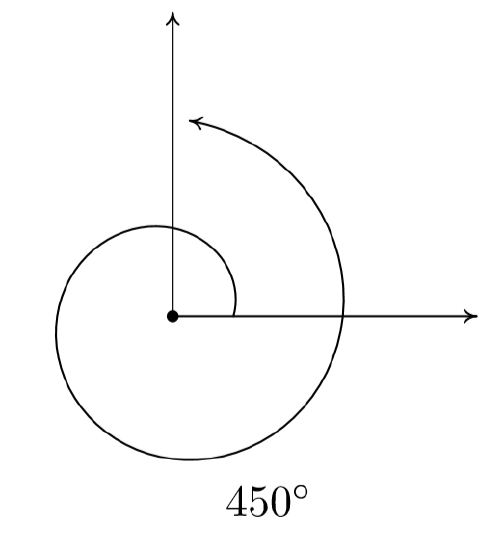
To further connect angles with the Algebra which has come before, we shall often overlay an angle diagram on the coordinate plane. An angle is said to be in standard position if its vertex is the origin and its initial side coincides with the positive x-axis. Angles in standard position are classified according to where their terminal side lies. For instance, an angle in standard position whose terminal side lies in Quadrant I is called a `Quadrant I angle'. If the terminal side of an angle lies on one of the coordinate axes, it is called a quadrantal angle. Two angles in standard position are called coterminal if they share the same terminal side.\footnote{Note that by being in standard position they automatically share the same initial side which is the positive x-axis.} In the figure below, α=120∘ and β=−240∘ are two coterminal Quadrant II angles drawn in standard position. Note that α=β+360∘, or equivalently, β=α−360∘. We leave it as an exercise to the reader to verify that coterminal angles always differ by a multiple of 360∘. (It is worth noting that all of the pathologies of Analytic Trigonometry result from this innocuous fact.) More precisely, if α and β are coterminal angles, then β=α+360∘⋅k where k is an integer. (Recall that this means k=0,±1,±2,….)
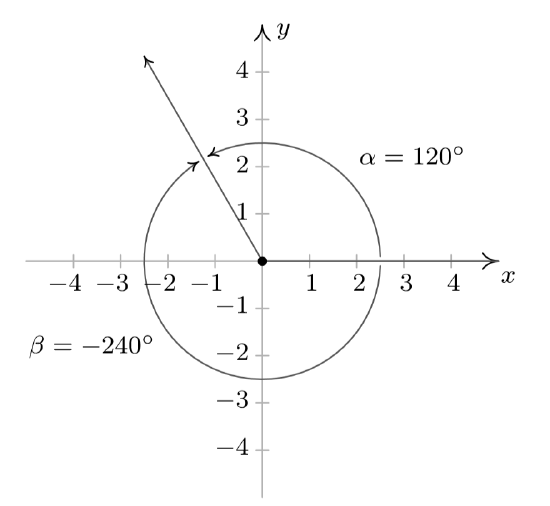
Two coterminal angles, α=120∘ and β=−240∘, in standard position.
Example 10.1.1: oriented coterminal angles in degrees
Graph each of the (oriented) angles below in standard position and classify them according to where their terminal side lies. Find three coterminal angles, at least one of which is positive and one of which is negative.
- α=60∘
- β=−225∘
- γ=540∘
- ϕ=−750∘
Solution
- To graph α=60∘, we draw an angle with its initial side on the positive x-axis and rotate counter-clockwise 60∘360∘=16 of a revolution. We see that α is a Quadrant I angle. To find angles which are coterminal, we look for angles θ of the form θ=α+360∘⋅k, for some integer k. When k=1, we get θ=60∘+360∘=420∘. Substituting k=−1 gives θ=60∘−360∘=−300∘. Finally, if we let k=2, we get θ=60∘+720∘=780∘.
- Since β=−225∘ is negative, we start at the positive x-axis and rotate \textit{clockwise} 225∘360∘=58 of a revolution. We see that β is a Quadrant II angle. To find coterminal angles, we proceed as before and compute θ=−225∘+360∘⋅k for integer values of k. We find 135∘, −585∘ and 495∘ are all coterminal with −225∘.
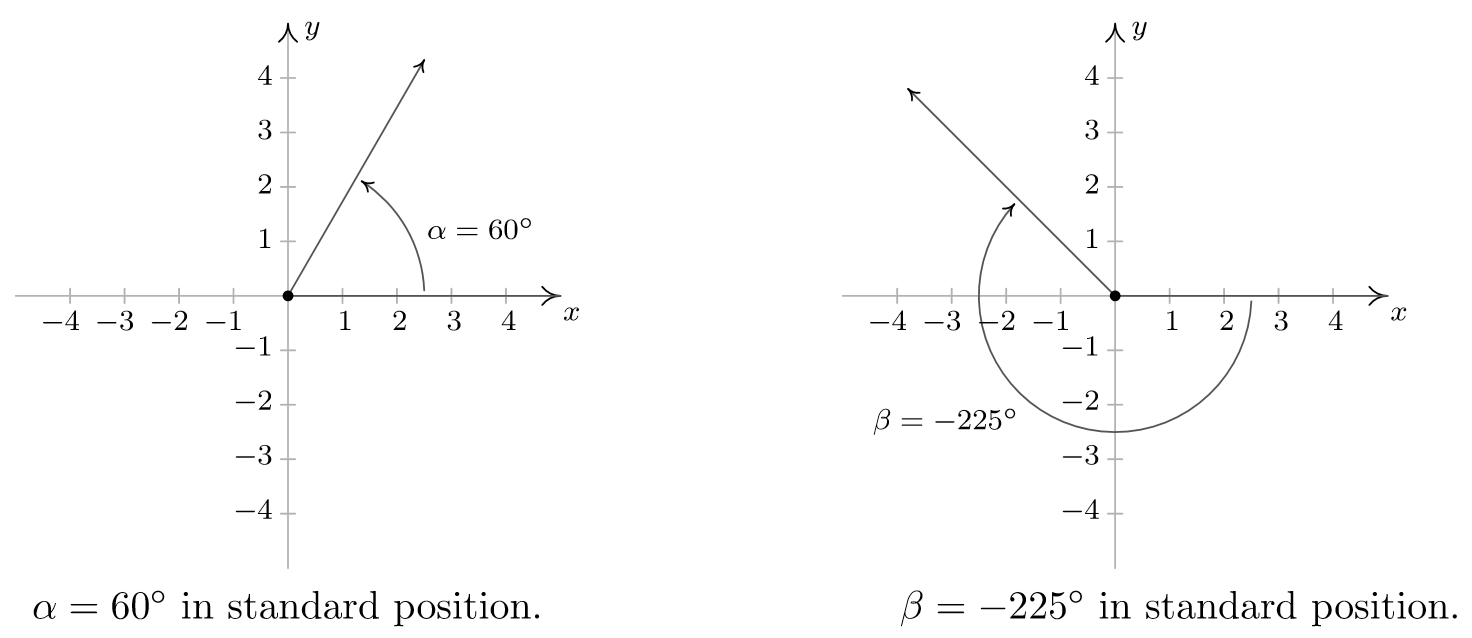
- Since γ=540∘ is positive, we rotate counter-clockwise from the positive x-axis. One full revolution accounts for 360∘, with 180∘, or 12 of a revolution remaining. Since the terminal side of γ lies on the negative x-axis, γ is a quadrantal angle. All angles coterminal with γ are of the form θ=540∘+360∘⋅k, where k is an integer. Working through the arithmetic, we find three such angles: 180∘, −180∘ and 900∘.
- The Greek letter ϕ is pronounced `fee' or `fie' and since ϕ is negative, we begin our rotation clockwise from the positive x$−axis.Twofullrevolutionsaccountfor\(720∘, with just 30∘ or 112 of a revolution to go. We find that ϕ is a Quadrant IV angle. To find coterminal angles, we compute θ=−750∘+360∘⋅k for a few integers k and obtain −390∘, −30∘ and 330∘.
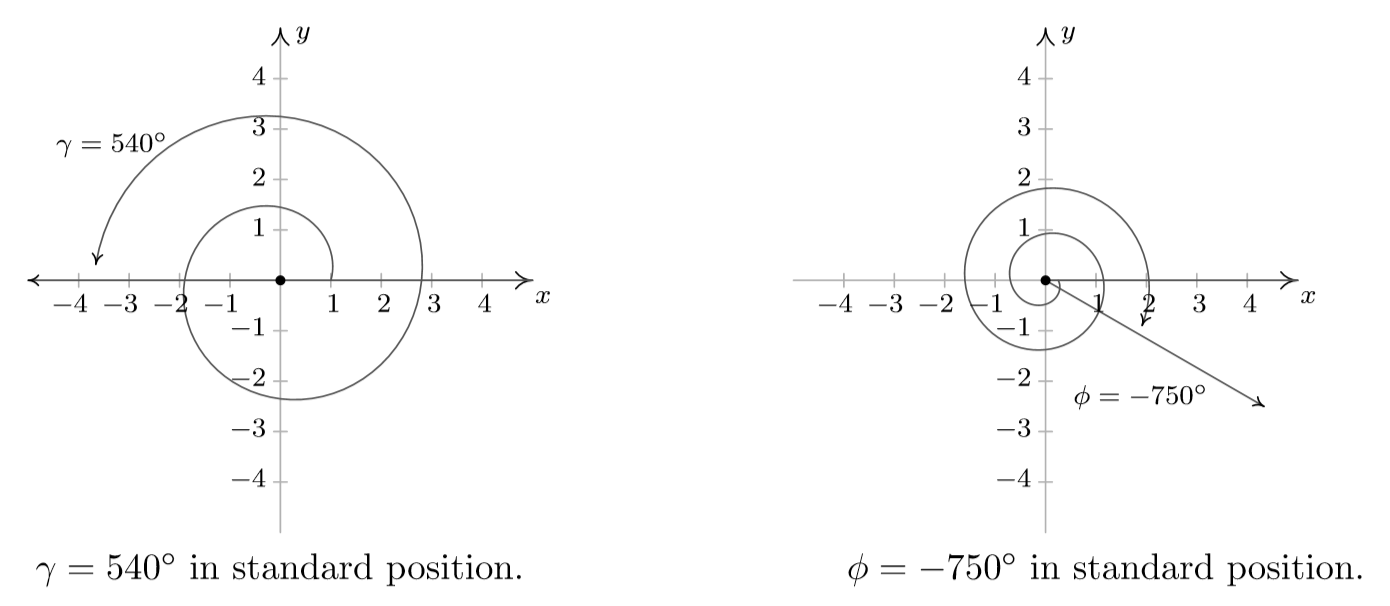
Note that since there are infinitely many integers, any given angle has infinitely many coterminal angles, and the reader is encouraged to plot the few sets of coterminal angles found in Example ??? to see this. We are now just one step away from completely marrying angles with the real numbers and the rest of Algebra. To that end, we recall this definition from Geometry.
Definition: π
The real number π is defined to be the ratio of a circle's circumference to its diameter. In symbols, given a circle of circumference C and diameter d,
While this Definition for π is quite possibly the `standard' definition of π, the authors would be remiss if we didn't mention that buried in this definition is actually a theorem. As the reader is probably aware, the number π is a mathematical constant - that is, it doesn't matter which circle is selected, the ratio of its circumference to its diameter will have the same value as any other circle. While this is indeed true, it is far from obvious and leads to a counterintuitive scenario which is explored in the Exercises. Since the diameter of a circle is twice its radius, we can quickly rearrange the equation in the Definition for π to get a formula more useful for our purposes, namely: 2π=Cr.
This tells us that for any circle, the ratio of its circumference to its radius is also always constant; in this case the constant is 2π. Suppose now we take a \textit{portion} of the circle, so instead of comparing the entire circumference C to the radius, we compare some arc measuring s units in length to the radius, as depicted below. Let θ be the central angle subtended by this arc, that is, an angle whose vertex is the center of the circle and whose determining rays pass through the endpoints of the arc. Using proportionality arguments, it stands to reason that the ratio sr should also be a constant among all circles, and it is this ratio which defines the radian measure of an angle.
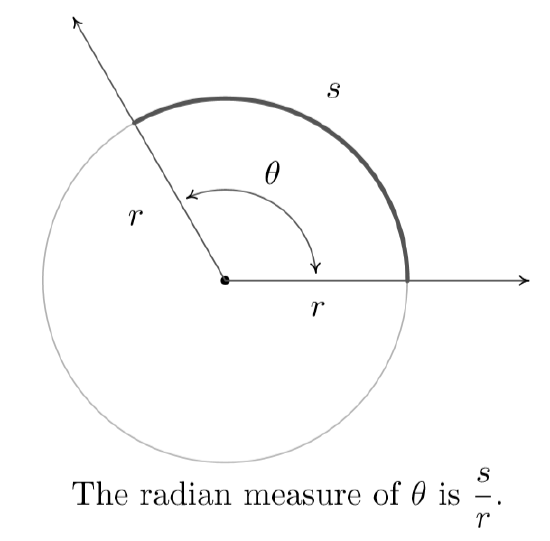
To get a better feel for radian measure, we note that an angle with radian measure 1 means the corresponding arc length s equals the radius of the circle r, hence s=r. When the radian measure is 2, we have s=2r; when the radian measure is 3, s=3r, and so forth. Thus the radian measure of an angle θ tells us how many `radius lengths' we need to sweep out along the circle to subtend the angle θ.

Since one revolution sweeps out the entire circumference 2πr, one revolution has radian measure 2πrr=2π. From this we can find the radian measure of other central angles using proportions, just like we did with degrees. For instance, half of a revolution has radian measure 12(2π)=π, a quarter revolution has radian measure 14(2π)=π2, and so forth. Note that, by definition, the radian measure of an angle is a length divided by another length so that these measurements are actually dimensionless and are considered `pure' numbers. For this reason, we do not use any symbols to denote radian measure, but we use the word `radians' to denote these dimensionless units as needed. For instance, we say one revolution measures `$2\pi\) radians,' half of a revolution measures `π radians,' and so forth.
As with degree measure, the distinction between the angle itself and its measure is often blurred in practice, so when we write `θ=π2', we mean θ is an angle which measures π2 radians. (The authors are well aware that we are now identifying radians with real numbers. We will justify this shortly.) We extend radian measure to oriented angles, just as we did with degrees beforehand, so that a positive measure indicates counter-clockwise rotation and a negative measure indicates clockwise rotation.\footnote{This, in turn, endows the subtended arcs with an orientation as well. We address this in short order.} Much like before, two positive angles α and β are supplementary if α+β=π and complementary if α+β=π2. Finally, we leave it to the reader to show that when using radian measure, two angles α and β are coterminal if and only if β=α+2πk for some integer k.
Example 10.1.3: orientedcoterminalradian
Graph each of the (oriented) angles below in standard position and classify them according to where their terminal side lies. Find three coterminal angles, at least one of which is positive and one of which is negative.
- α=π6
- β=−4π3
- γ=9π4
- ϕ=−5π2
Solution
- \item The angle α=π6 is positive, so we draw an angle with its initial side on the positive x-axis and rotate counter-clockwise (π/6)2π=112 of a revolution. Thus α is a Quadrant I angle. Coterminal angles θ are of the form θ=α+2π⋅k, for some integer k. To make the arithmetic a bit easier, we note that 2π=12π6, thus when k=1, we get θ=π6+12π6=13π6. Substituting k=−1 gives θ=π6−12π6=−11π6 and when we let k=2, we get θ=π6+24π6=25π6.
- \item Since β=−4π3 is negative, we start at the positive x-axis and rotate clockwise (4π/3)2π=23 of a revolution. We find β to be a Quadrant II angle. To find coterminal angles, we proceed as before using 2π=6π3, and compute θ=−4π3+6π3⋅k for integer values of k. We obtain 2π3, −10π3 and 8π3 as coterminal angles.
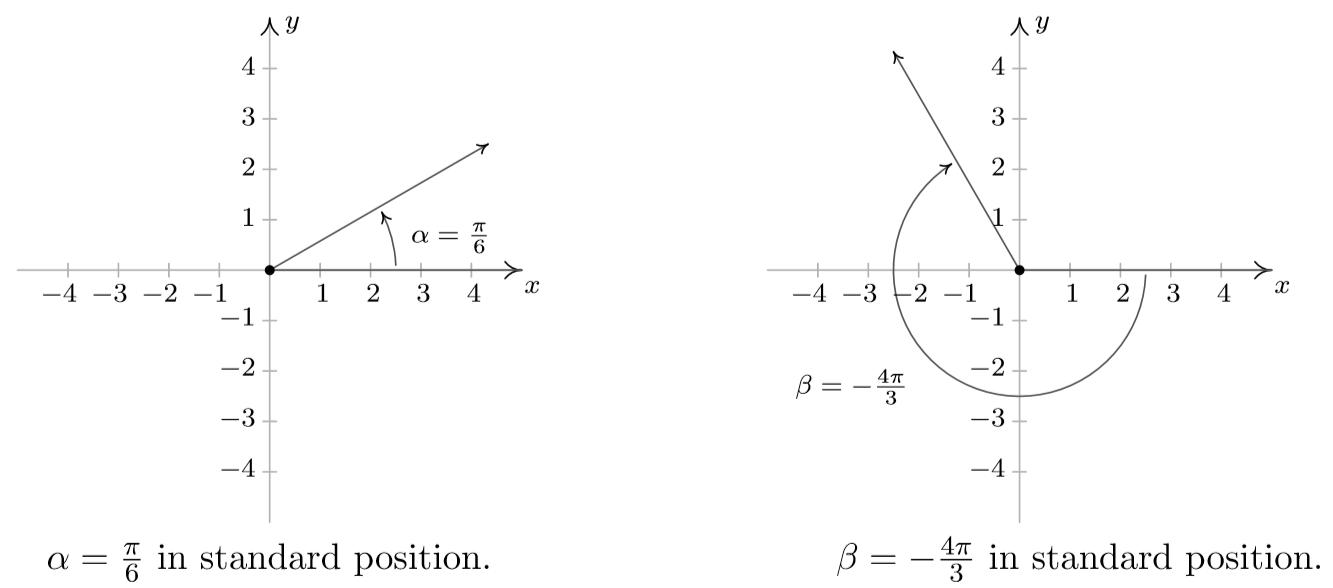
- Since γ=9π4 is positive, we rotate counter-clockwise from the positive x-axis. One full revolution accounts for 2π=8π4 of the radian measure with π4 or 18 of a revolution remaining. We have γ as a Quadrant I angle. All angles coterminal with γ are of the form θ=9π4+8π4⋅k, where k is an integer. Working through the arithmetic, we find: π4, −7π4 and 17π4.
- To graph ϕ=−5π2, we begin our rotation clockwise from the positive x-axis. As 2π=4π2, after one full revolution clockwise, we have π2 or 14 of a revolution remaining. Since the terminal side of ϕ lies on the negative y-axis, ϕ is a quadrantal angle. To find coterminal angles, we compute θ=−5π2+4π2⋅k for a few integers k and obtain −π2, 3π2 and 7π2.
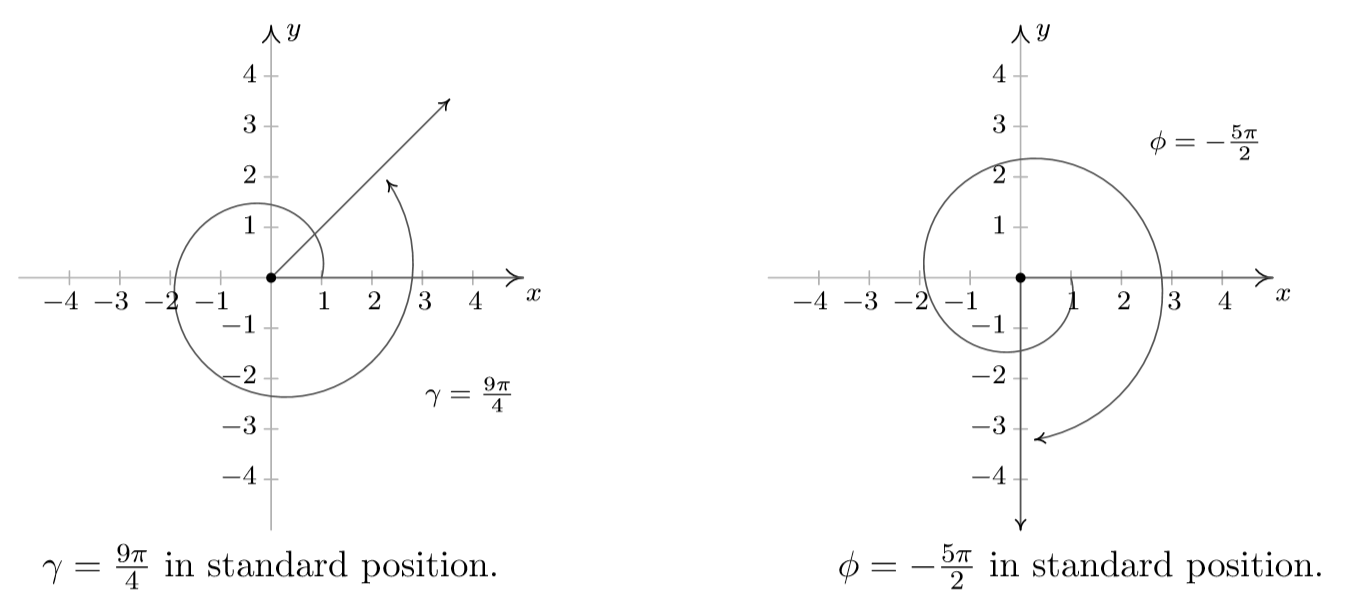
It is worth mentioning that we could have plotted the angles in Example ??? by first converting them to degree measure and following the procedure set forth in Example ???. While converting back and forth from degrees and radians is certainly a good skill to have, it is best that you learn to `think in radians' as well as you can `think in degrees'. The authors would, however, be derelict in our duties if we ignored the basic conversion between these systems altogether. Since one revolution counter-clockwise measures 360∘ and the same angle measures 2π radians, we can use the proportion 2πradians360∘, or its reduced equivalent, πradians180∘, as the conversion factor between the two systems. For example, to convert 60∘ to radians we find 60∘(πradians180∘)=π3radians, or simply π3. To convert from radian measure back to degrees, we multiply by the ratio 180∘πradian. For example, −5π6radians is equal to (−5π6radians)(180∘πradians)=−150∘.\footnote{Note that the negative sign indicates clockwise rotation in both systems, and so it is carried along accordingly.} Of particular interest is the fact that an angle which measures 1 in radian measure is equal to 180∘π≈57.2958∘.
We summarize these conversions below.
Note: Degree - Radian Conversion
- To convert degree measure to radian measure, multiply by πradians180∘
- To convert radian measure to degree measure, multiply by 180∘πradians
In light of Example ??? and Equation ???, the reader may well wonder what the allure of radian measure is. The numbers involved are, admittedly, much more complicated than degree measure. The answer lies in how easily angles in radian measure can be identified with real numbers. Consider the Unit Circle, x2+y2=1, as drawn below, the angle θ in standard position and the corresponding arc measuring s units in length. By definition, and the fact that the Unit Circle has radius 1, the radian measure of θ is sr=s1=s so that, once again blurring the distinction between an angle and its measure, we have θ=s. In order to identify real numbers with oriented angles, we make good use of this fact by essentially `wrapping' \index{wrapping function} the real number line around the Unit Circle and associating to each real number t an \textit{oriented} arc \index{oriented arc} on the Unit Circle with initial point (1,0).
Viewing the vertical line x=1 as another real number line demarcated like the y-axis, given a real number t>0, we `wrap' the (vertical) interval [0,t] around the Unit Circle in a counter-clockwise fashion. The resulting arc has a length of t units and therefore the corresponding angle has radian measure equal to t. If t<0, we wrap the interval [t,0] \textit{clockwise} around the Unit Circle. Since we have defined clockwise rotation as having negative radian measure, the angle determined by this arc has radian measure equal to t. If t=0, we are at the point (1,0) on the x-axis which corresponds to an angle with radian measure 0. In this way, we identify each real number t with the corresponding angle with radian measure t.
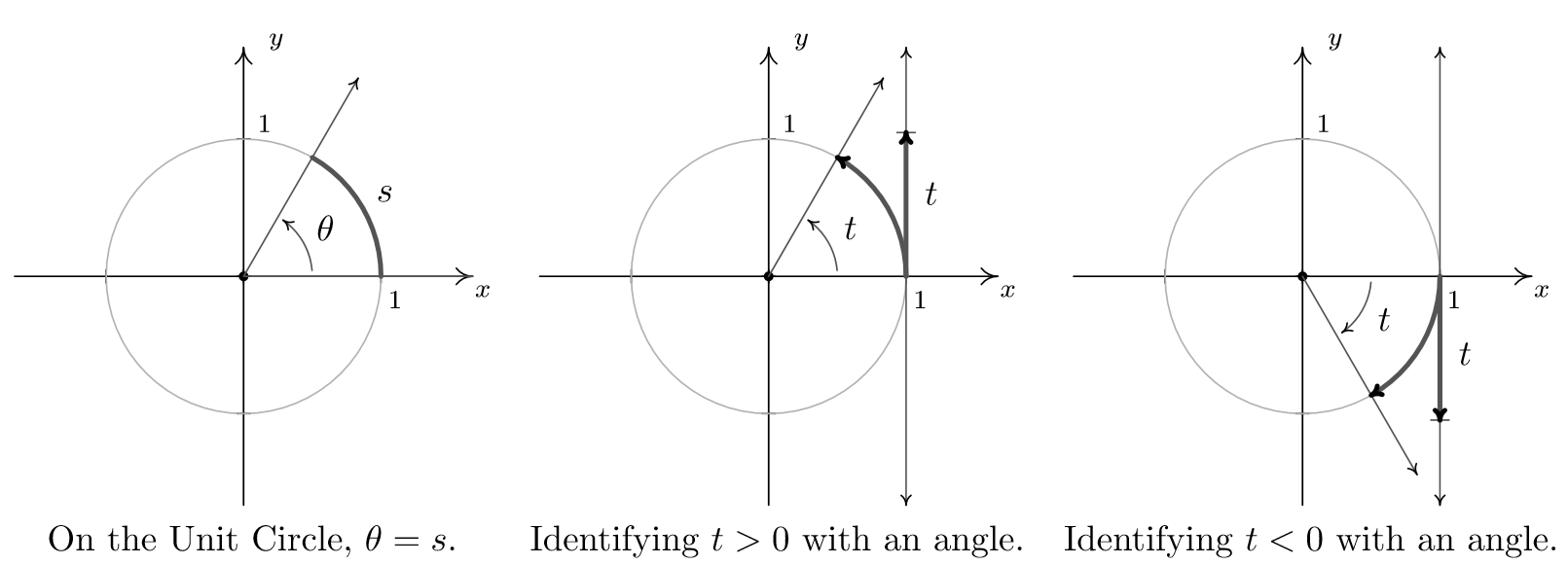
Example 10.1.1:
Sketch the oriented arc on the Unit Circle corresponding to each of the following real numbers.
- t=3π4
- t=−2π
- t=−2
- t=117
Solution
- The arc associated with t=3π4 is the arc on the Unit Circle which subtends the angle 3π4 in radian measure. Since 3π4 is 38 of a revolution, we have an arc which begins at the point (1,0) proceeds counter-clockwise up to midway through Quadrant II.
- Since one revolution is 2π radians, and t=−2π is negative, we graph the arc which begins at (1,0) and proceeds clockwise for one full revolution.
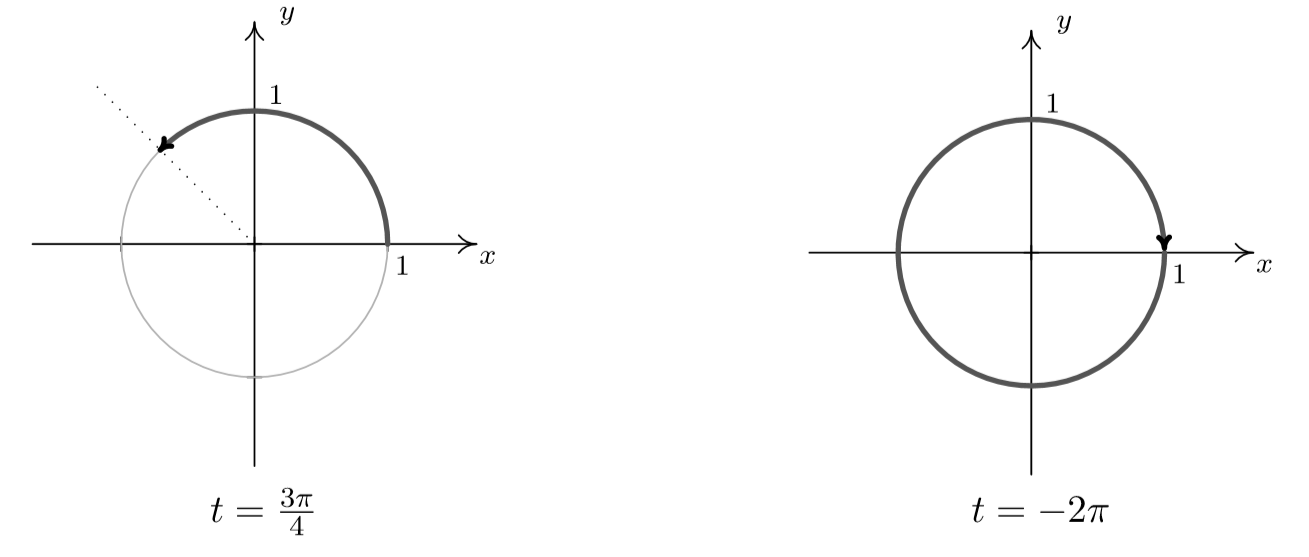
- Like t=−2π, t=−2 is negative, so we begin our arc at (1,0) and proceed clockwise around the unit circle. Since π≈3.14 and π2≈1.57, we find that rotating 2 radians clockwise from the point (1,0) lands us in Quadrant III. To more accurately place the endpoint, we proceed as we did in Example ???, successively halving the angle measure until we find 5π8≈1.96 which tells us our arc extends just a bit beyond the quarter mark into Quadrant III.
- Since 117 is positive, the arc corresponding to t=117 begins at (1,0) and proceeds counter-clockwise. As 117 is much greater than 2π, we wrap around the Unit Circle several times before finally reaching our endpoint. We approximate 1172π as 18.62 which tells us we complete 18 revolutions counter-clockwise with 0.62, or just shy of 58 of a revolution to spare. In other words, the terminal side of the angle which measures 117 radians in standard position is just short of being midway through Quadrant III.

Applications of Radian Measure: Circular Motion
Now that we have paired angles with real numbers via radian measure, a whole world of applications awaits us. Our first excursion into this realm comes by way of circular motion. Suppose an object is moving as pictured below along a circular path of radius r from the point P to the point Q in an amount of time t.
\begin{center}
\begin{mfpic}[14]{-5}{5}{-5}{5}
\tlabel[cc](3.25,-0.5){\small \(P$}
\tlabel[cc](1.25,3.25){\small \(Q$}
\tlabel[cc](1.5,-0.5){\small \(r$}
\point[3pt]{(0,0), (3,0), (1.5, 2.5981)}
\drawcolor[gray]{0.7}
\circle{(0,0),3}
\drawcolor[rgb]{0.33,0.33,0.33}
\arrow \reverse \arrow \polyline{(5, 0), (0,0), (2.5, 4.3301)}
\arrow \parafcn{5, 55, 5}{1.5*dir(t)}
\tlabel[cc](1.732, 1){$\theta$}
\penwd{1.5pt}
\arrow \parafcn{0,60,5}{3*dir(t)}
\tlabel[cc](3.0311,1.75){$s$}
\end{mfpic}
\end{center}
Here s represents a \textit{displacement} so that s>0 means the object is traveling in a counter-clockwise direction and s<0 indicates movement in a clockwise direction. Note that with this convention the formula we used to define radian measure, namely θ=sr, still holds since a negative value of s incurred from a clockwise displacement matches the negative we assign to θ for a clockwise rotation. In Physics, the \textbf{average velocity} \index{average velocity} of the object, denoted ¯v and read as `$v$-bar', is defined as the average rate of change of the position of the object with respect to time.\footnote{See Definition ??? in Section ??? for a review of this concept.} As a result, we have ¯v=displacementtime=st. The quantity ¯v has units of lengthtime and conveys two ideas: the direction in which the object is moving and how fast the position of the object is changing. The contribution of direction in the quantity ¯v is either to make it positive (in the case of counter-clockwise motion) or negative (in the case of clockwise motion), so that the quantity |¯v| quantifies how fast the object is moving - it is the \textbf{speed} of the object. Measuring θ in radians we have θ=sr thus s=rθ and ¯v=st=rθt=r⋅θt The quantity θt is called the \index{velocity ! average angular}\index{average angular velocity}\textbf{average angular velocity} of the object. It is denoted by ¯ω and is read `omega-bar'. The quantity ¯ω is the average rate of change of the angle θ with respect to time and thus has units radianstime. If \overline{\omega} is constant throughout the duration of the motion, then it can be shown\footnote{You guessed it, using Calculus \ldots} that the average velocities involved, namely \overline{v} and \overline{\omega}, are the same as their instantaneous counterparts, v and \omega, respectively. In this case, v is simply called the \index{velocity ! instantaneous}`velocity' of the object and is the instantaneous rate of change \index{instantaneous rate of change} of the position of the object with respect to time.\footnote{See the discussion on Page \pageref{instantaneousrateofchange} for more details on the idea of an `instantaneous' rate of change.} Similarly, \omega is called the \index{velocity ! instantaneous angular}`angular velocity' and is the instantaneous rate of change of the angle with respect to time.
If the path of the object were `uncurled' from a circle to form a line segment, then the velocity of the object on that line segment would be the same as the velocity on the circle. For this reason, the quantity v is often called the \textit{linear} velocity of the object in order to distinguish it from the \textit{angular} velocity, \omega. Putting together the ideas of the previous paragraph, we get the following.
Note: Circular Motion Velocity
Velocity for Circular Motion:} For an object moving on a circular path of radius r with constant angular velocity \omega, the (linear) velocity of the object is given by v = r \omega.
We need to talk about units here. The units of v are \frac{\text{length}}{\text{time}}, the units of r are length only, and the units of \omega are \frac{\text{radians}}{\text{time}}. Thus the left hand side of the equation v = r \omega has units \frac{\text{length}}{\text{time}}, whereas the right hand side has units \text{length} \cdot \frac{\text{radians}}{\text{time}} = \frac{\text{length} \cdot \text{radians}}{\text{time}} \(. The supposed contradiction in units is resolved by remembering that radians are a dimensionless quantity and angles in radian measure are identified with real numbers so that the units \(\frac{\text{length} \cdot \text{radians}}{\text{time}} reduce to the units \frac{\text{length}}{\text{time}}. We are long overdue for an example.
Example \PageIndex{4}: EarthRotationEx
Assuming that the surface of the Earth is a sphere, any point on the Earth can be thought of as an object traveling on a circle which completes one revolution in (approximately) 24 hours. The path traced out by the point during this 24 hour period is the Latitude of that point. Lakeland Community College is at 41.628^{\circ} north latitude, and it can be shown\footnote{We will discuss how we arrived at this approximation in Example \ref{cosinesinecircleex}.} that the radius of the earth at this Latitude is approximately 2960 miles. Find the linear velocity, in miles per hour, of Lakeland Community College as the world turns.
Solution
To use the formula v = r \omega, we first need to compute the angular velocity \omega. The earth makes one revolution in 24 hours, and one revolution is 2 \pi radians, so \omega = \frac{2 \pi \, \text{radians}}{24 \, \text{hours}} = \frac{\pi}{12 \, \text{hours}}, where, once again, we are using the fact that radians are real numbers and are dimensionless. (For simplicity's sake, we are also assuming that we are viewing the rotation of the earth as counter-clockwise so \omega > 0.) Hence, the linear velocity is v = 2960 \, \text{miles} \cdot \frac{\pi}{12 \, \text{hours}} \approx 775 \, \frac{\text{miles}}{\text{hour}} \qed
It is worth noting that the quantity \frac{1 \, \text{revolution}}{24 \, \text{hours}} in Example \ref{EarthRotationEx} is called the \index{frequency ! ordinary} \index{ordinary frequency} \textbf{ordinary frequency} of the motion and is usually denoted by the variable f. The ordinary frequency is a measure of how often an object makes a complete cycle of the motion. The fact that \omega = 2\pi f suggests that \omega is also a frequency. Indeed, it is called the \index{frequency ! angular} \index{angular frequency} \textbf{angular frequency} of the motion. On a related note, the quantity T = \dfrac{1}{f} is called the \index{period ! circular motion}\textbf{period} of the motion and is the amount of time it takes for the object to complete one cycle of the motion. In the scenario of Example \ref{EarthRotationEx}, the period of the motion is 24 hours, or one day.
The concepts of frequency and period help frame the equation v = r \omega in a new light. That is, if \omega is fixed, points which are farther from the center of rotation need to travel faster to maintain the same angular frequency since they have farther to travel to make one revolution in one period's time. The distance of the object to the center of rotation is the radius of the circle, r, and is the `magnification factor' which relates \omega and v. We will have more to say about frequencies and periods in Section \ref{Sinusoid}. While we have exhaustively discussed velocities associated with circular motion, we have yet to discuss a more natural question: if an object is moving on a circular path of radius r with a fixed angular velocity (frequency) \omega, what is the position of the object at time \(t$? The answer to this question is the very heart of Trigonometry and is answered in the next section.

